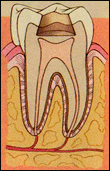


DO YOU HAVE A TOOTH THAT NEEDS
Fixing? If one of your teeth has been damaged by decay or an injury, prompt repair will prevent bigger and more painful problems later on. This booklet will show how your dentist can restore your tooth to working order.
THE BIG FIX
Tooth repair can make the difference between saving and losing damaged tooth. Dentists can repair a tooth that has decayed or been injured and can restore it to its normal function. The three most common procedures are fillings, crowns, and root canals.




When decay creates a cavity in a tooth, the dentist usually fills it with durable material-most often gold, a composite resin (a tooth-colored plastic), or a metal alloy called amalgam.
Visits needed: One.
Durability: The lifespan of a filling depends on its location, the material used, and the care you give your teeth. Gold can last from five to more than 20 years: amalgam or a composite resin can last five to 15 years.


CROWNS
A crown is cover for a tooth that’s been weakened by decay (right) or by recurrent fillings. A crown may also be required after a root canal or when a tooth has broken or cracked. The most common material used include gold, porcelain, and metal alloys.
Visits needed: Two
Durability: Crowns can last from five to more than 20 years, depending on the material used. Gold is the most durable.
ROOT CANALS
If a tooth’s which contains nerves and blood vessels, becomes infected or damaged because of deep decay or an injury, root-canal treatment may be the only way to save the tooth. The procedure cleans out the pulp chamber and repairs the damage.
Visits needed: One to three, depending on the condition of the pulp. If the tooth is abscessed (meaning the pulp has died and the infection has entered the bone anchoring the tooth), the infection may have to drain before the empty root can be filled.
Durability: The material used to fill the root canal will probably last the rest of your life. But you may eventually need to have the filling or crown replaced.
- During your first visit, the dentist removes the decay and a small amount of enamel (slightly more than the thickness of a dime) from the surface of the affected tooth. He or she then shapes the tooth into a base for the crown to fit over. An impression is made of the tooth so that the crown will be exact fit. A temporary crown is then put on.
- After the affected tooth has been numbed, the dentist makes an opening in the top of the tooth to reach the pulp chamber. The pulp is then removed and the chamber and root(s) are rinsed out.
- On your return visit, the permanent crown is cemented on the tooth. This visit generally takes just a few minutes and may not require anesthetic.
- Once the pulp chamber and root canal system are clean and free of infection, these areas are filled with a rubberlike material. Finally, the tooth is crowned or filled (shown) to seal the opening to the pulp chamber.


Taking care of Repaired Teeth
FOR FILLINGS- Avoid hard or chewy foods for 24 hours if you’ve had an amalgam filling. It may continue to harden during this time.
- Eat normally if you’ve had a composite-resin or gold filling, it’s as hard as it’s going to get when you leave the dentist’s office.
- Call your dentist if a filling falls out or feels loose.
FOR CROWNS AND ROOT CANALS
- Don’t be surprised if your tooth is sensitive for a few days if you’ve had a crown or root canal done. A crowned tooth may be temporarily sensitive to heat and cold, and a tooth that has had a root canal may be tender because the surrounding tissue is inflamed. Over –the-counter pain relievers can reduce discomfort following a root canal.
- Floss around the edges of your crown. The tooth may be protected by the crown,, but the gumline and adjacent teeth are still susceptible to trapped food and plaque buildup, which can result in gum disease or additional decay.
- Call your dentist if a crown falls off or feels loose.



